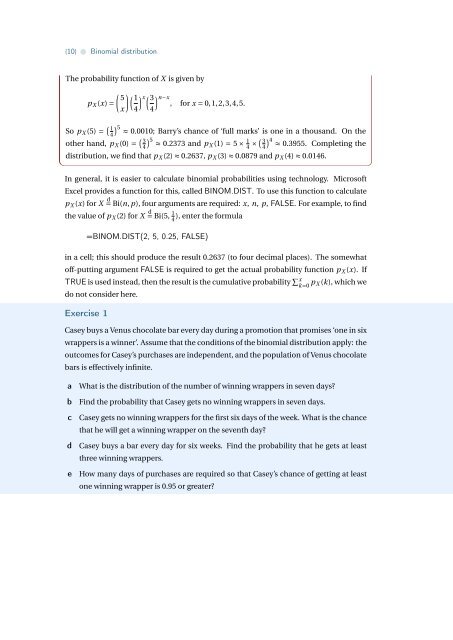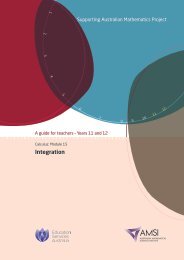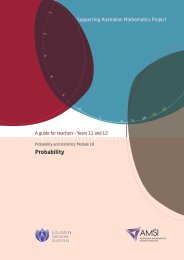Binomial distribution - the Australian Mathematical Sciences Institute
Binomial distribution - the Australian Mathematical Sciences Institute
Binomial distribution - the Australian Mathematical Sciences Institute
Create successful ePaper yourself
Turn your PDF publications into a flip-book with our unique Google optimized e-Paper software.
{10} • <strong>Binomial</strong> <strong>distribution</strong><br />
The probability function of X is given by<br />
( ) 5 ( 1<br />
) x ( 3<br />
) n−x,<br />
p X (x) =<br />
for x = 0,1,2,3,4,5.<br />
x 4 4<br />
So p X (5) = ( 1 5<br />
4)<br />
≈ 0.0010; Barry’s chance of ‘full marks’ is one in a thousand. On <strong>the</strong><br />
o<strong>the</strong>r hand, p X (0) = ( )<br />
3 5<br />
4 ≈ 0.2373 and pX (1) = 5 × 1 4 × ( 3 4<br />
4)<br />
≈ 0.3955. Completing <strong>the</strong><br />
<strong>distribution</strong>, we find that p X (2) ≈ 0.2637, p X (3) ≈ 0.0879 and p X (4) ≈ 0.0146.<br />
In general, it is easier to calculate binomial probabilities using technology. Microsoft<br />
Excel provides a function for this, called BINOM.DIST. To use this function to calculate<br />
p X (x) for X d = Bi(n, p), four arguments are required: x, n, p, FALSE. For example, to find<br />
<strong>the</strong> value of p X (2) for X = d Bi(5, 1 4<br />
), enter <strong>the</strong> formula<br />
=BINOM.DIST(2, 5, 0.25, FALSE)<br />
in a cell; this should produce <strong>the</strong> result 0.2637 (to four decimal places). The somewhat<br />
off-putting argument FALSE is required to get <strong>the</strong> actual probability function p X (x). If<br />
TRUE is used instead, <strong>the</strong>n <strong>the</strong> result is <strong>the</strong> cumulative probability ∑ x<br />
k=0 p X (k), which we<br />
do not consider here.<br />
Exercise 1<br />
Casey buys a Venus chocolate bar every day during a promotion that promises ‘one in six<br />
wrappers is a winner’. Assume that <strong>the</strong> conditions of <strong>the</strong> binomial <strong>distribution</strong> apply: <strong>the</strong><br />
outcomes for Casey’s purchases are independent, and <strong>the</strong> population of Venus chocolate<br />
bars is effectively infinite.<br />
a<br />
b<br />
c<br />
d<br />
e<br />
What is <strong>the</strong> <strong>distribution</strong> of <strong>the</strong> number of winning wrappers in seven days<br />
Find <strong>the</strong> probability that Casey gets no winning wrappers in seven days.<br />
Casey gets no winning wrappers for <strong>the</strong> first six days of <strong>the</strong> week. What is <strong>the</strong> chance<br />
that he will get a winning wrapper on <strong>the</strong> seventh day<br />
Casey buys a bar every day for six weeks. Find <strong>the</strong> probability that he gets at least<br />
three winning wrappers.<br />
How many days of purchases are required so that Casey’s chance of getting at least<br />
one winning wrapper is 0.95 or greater

















